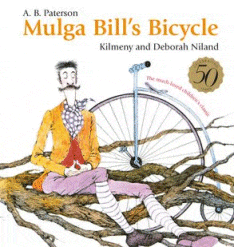
Mulga Bills Bicycle
Mulga Bill’s Bicycle: 50th Anniversary Edition
A. B. (Banjo) Paterson
Kilmeny Niland, Deborah Niland
HarperCollins, 2023
32pp., hbk., RRP $A24.99
9781460763728
“Twas Mulga Bill from Eaglehawk, that caught the cycling craze’
He turned away the good old horse that served him many days;
He dressed himself in cycling clothes, resplendent to be seen’
He hurried of to town and bought a shining new machine…”
But despite his boasting that “there’s none can ride like me”, he finds getting on the penny-farthing difficult enough and that riding is nothing like he anticipated…
This is one of Banjo Paterson’s classics, an hilarious tale of misadventure, that was first brought to life for young readers by the illustrations of sisters Kilmeny and Deborah Niland in 1973 and has remained a favourite on library shelves for 50 years, often being the introduction to other works by Paterson for those same young readers. While Paterson’s words tell the story of Mulga Bill’s crazy ride, it is the action and expressions that have been captured in the illustrations that ensure the reader is totally immersed in the story, invested in the inevitable outcome – can anyone survive such an out-of-control ride?
While bicycles have certainly changed since this poem was first published in 1896, perhaps sparking an investigation into how they, or even transport and travel itself has evolved since then, Bill’s embracing the new technology remains the same for many. There are always going to be the early adopters and the late bloomers and students might like to consider which they are and the pros and cons of each approach. Some have suggested that in the era that the poem was written, the “safety bicycle” would have been more common that the penny-farthing and that perhaps the illustrators used poetic licence with Paterson’s words to create something more appealing, opening opportunities to discuss whether it is okay to do this, or to rearrange historical events or geographical places and so forth to make a story more engaging. Should the fiction have precedence over the facts? Some students may even have examples they can share as authors acknowledge their fiddling with the facts in many historical stories.
Or they might just enjoy this 50th anniversary edition for the fun and laughter it evokes!
